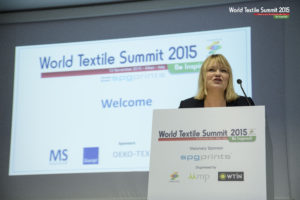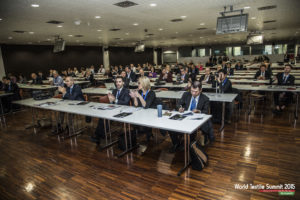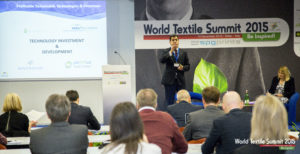 The United Nations Climate Change Conference, held in Paris from November 30th to December 11th, has been defined the last call to find a real agreement on reducing the human impact on the natural environment. Pollution is not far from the point of no return, therefore it hasn’t been a surprise that the latest edition of the World Textile Summit, that took place in Milan on November 13th during Itma, was focused on sustainability.
The United Nations Climate Change Conference, held in Paris from November 30th to December 11th, has been defined the last call to find a real agreement on reducing the human impact on the natural environment. Pollution is not far from the point of no return, therefore it hasn’t been a surprise that the latest edition of the World Textile Summit, that took place in Milan on November 13th during Itma, was focused on sustainability.
Organized by Cematex (the European association of textile machinery manufacturers), Mp Expositions and World Textile Information Network, the event tried to find a reply to a difficult question: is sustainability a pure matter of ethics and of technical compliance, or do its effects reach the bottom line, with real business advantages for companies? In other words: is sustainability good for business?
 The panel of textile manufacturers, experts and advisers that gathered to find this reply was impressive. The first speaker was Mary Porter-Peschka, director of International Finance Corporation (World Bank) that highlighted the fact that manufacturers are usually more inclined to invest in efficiency, for example to save water and energy in the production processes, because it is easier to calculate the return of investment. It is more difficult for them to have a clear vision on how other improvements can benefit their companies, so Porter-Peschka stressed the importance of education in order to enable producers to know how sustainability can impact on profitability.
The panel of textile manufacturers, experts and advisers that gathered to find this reply was impressive. The first speaker was Mary Porter-Peschka, director of International Finance Corporation (World Bank) that highlighted the fact that manufacturers are usually more inclined to invest in efficiency, for example to save water and energy in the production processes, because it is easier to calculate the return of investment. It is more difficult for them to have a clear vision on how other improvements can benefit their companies, so Porter-Peschka stressed the importance of education in order to enable producers to know how sustainability can impact on profitability.
Indirectly a confirm to this situation came from one of the protagonists of one of the following round tables, Maurizio Ribotti, marketing manager of Canepa, an Italian weaving factory based in Como, that presented to the audience its experience in organizing a number of meetings with its clients and suppliers to explain its significant efforts and projects on sustainability (for example, Canepa was the first textile manufacturer to sign up to the Greenpeace-promoted Detox Initiative); despite those educational rounds, Ribotti remarked that a lot still has to be done to increase the awareness on the importance of this topic.
The Customer’s Point of View
A stimulus towards this direction is coming from final consumers. Paula Oliveira, director of Interbrand, international brand consultancy, provided very interesting data about the demand of sustainability on the market: 66% of worldwide consumers would like to buy products from companies that have social responsibility projects, and this share rises to 89% for people among 21 and 34 years old. Corporate social responsibility (CSR) has become more relevant than other aspects and clients are more willing to pay a price surcharge to buy sustainable goods. In three years (from 2011 to 2014) this openness has reached an average global growth of 10%, ranging from 13% of Latin America to 8% of Europe and 9% of Asia. «In the new circular economy – Oliveira said – information and values are more pervasive, the entire production and retail chains are connected with final consumers. They are more aware and attentive, so “greenwashing” is very risky because if a manufacturer’s commitment is just a façade, it is easily abandoned and “banned”. Company’s reputation is capital not just for this but also to attract talents to work with».
A report released by McKinsey last September reveals that adopting circular-economy principles could generate a net economic benefit to Europe alone of € 1.8 trillion by 2030. Helga Vanthournout, Engagement Manager at the consulting company, showed the World Textile Summit participants what this entails: a framework where products made with finite materials have to be managed in order to share and reuse them, to prolong their lifetime, and then be recycled and put into remanufacturing chain; regarding renewable materials, the flow can be optimized through collaboration, sharing and regeneration. The process involves raw materials sources, production and retail chains and, of course, consumers, spreading awareness and ethics. What was really astonishing in Vanthournout’s speech, is that, according to McKinsey researchers, the main barriers against the adoption of alternative sources of energy and water, chemicals and waste usage, as well as for more efficient resources management, are not technical but behavioural, even more than financial.
Not Only a Question of Ethics
 On the money side, there is a new wave of capital ventures that are seeking opportunities on the sustainability market. One of these is Aloe Group, whose co-founder Vivek Tandon described how his private equity is strongly investing in companies and technologies that create new products from waste. The example provided by Tandon for textile is PerPETual Global, the only company in the world which manufactures high-quality esters from post-consumer PET bottles, located in Nashik, India, where every day 1.5 million of plastic bottles become polyester yarns ranging from 80 to 1800 denier for different uses, including apparel. Moreover, PerPETual is developing, among others, a process and a technology to recycle polyester fabric waste into yarns, that can become again fabrics and garment, in a quite endless system.
On the money side, there is a new wave of capital ventures that are seeking opportunities on the sustainability market. One of these is Aloe Group, whose co-founder Vivek Tandon described how his private equity is strongly investing in companies and technologies that create new products from waste. The example provided by Tandon for textile is PerPETual Global, the only company in the world which manufactures high-quality esters from post-consumer PET bottles, located in Nashik, India, where every day 1.5 million of plastic bottles become polyester yarns ranging from 80 to 1800 denier for different uses, including apparel. Moreover, PerPETual is developing, among others, a process and a technology to recycle polyester fabric waste into yarns, that can become again fabrics and garment, in a quite endless system.
A good example of engagement for environment care came Kering, the holding that owns most of worldwide luxury apparel brands, that just before the World Textile Summit released a report on the production environment impact of each one of its companies, with the aim of understanding how each manufacturing phase can be improved. «We start from raw materials – Helen Crowley, Kering’s Head of sustainable sourcing innovation, explained – because they have a direct impact on climate changes and the enhancement margins are huge. Lands recover and safeguard are capital».
Speaking about sustainability one of the main issues for the companies is usually connected to their dimensions: if for larger companies it is quite easy to invest in corporate social responsibility, for SMEs it is more difficult. The impact of a single citizen or plant is a drop in the ocean, but building collaboration networks in the supply chain could be a solution to obtain bigger results and to reduce investment costs. This is the solution suggested by Christian Dietrich, director of Systain Consulting, that using the “crowd approach”, has successfully helped a group of German apparel retailers to reduce their carbon emissions under the Carbon Performance Improvement Initiative. Now this tool is available online (www.cpi2.org in six languages) and it is currently used by more than 1,000 textile factories in 25 countries.
by Debora Ferrero




